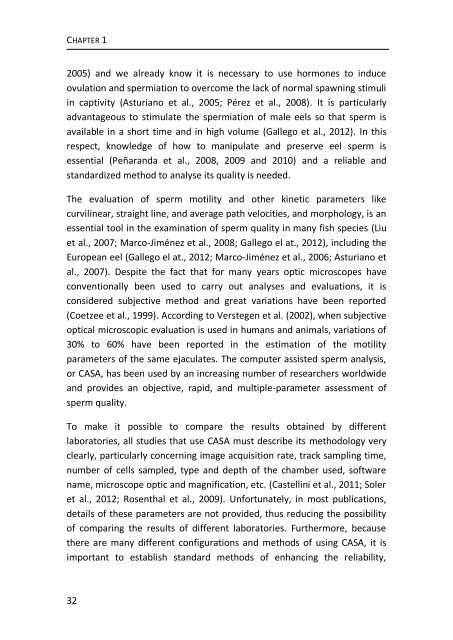chapter 3 - RiuNet
chapter 3 - RiuNet
chapter 3 - RiuNet
You also want an ePaper? Increase the reach of your titles
YUMPU automatically turns print PDFs into web optimized ePapers that Google loves.
CHAPTER 1<br />
2005) and we already know it is necessary to use hormones to induce<br />
ovulation and spermiation to overcome the lack of normal spawning stimuli<br />
in captivity (Asturiano et al., 2005; Pérez et al., 2008). It is particularly<br />
advantageous to stimulate the spermiation of male eels so that sperm is<br />
available in a short time and in high volume (Gallego et al., 2012). In this<br />
respect, knowledge of how to manipulate and preserve eel sperm is<br />
essential (Peñaranda et al., 2008, 2009 and 2010) and a reliable and<br />
standardized method to analyse its quality is needed.<br />
The evaluation of sperm motility and other kinetic parameters like<br />
curvilinear, straight line, and average path velocities, and morphology, is an<br />
essential tool in the examination of sperm quality in many fish species (Liu<br />
et al., 2007; Marco-Jiménez et al., 2008; Gallego el at., 2012), including the<br />
European eel (Gallego el at., 2012; Marco-Jiménez et al., 2006; Asturiano et<br />
al., 2007). Despite the fact that for many years optic microscopes have<br />
conventionally been used to carry out analyses and evaluations, it is<br />
considered subjective method and great variations have been reported<br />
(Coetzee et al., 1999). According to Verstegen et al. (2002), when subjective<br />
optical microscopic evaluation is used in humans and animals, variations of<br />
30% to 60% have been reported in the estimation of the motility<br />
parameters of the same ejaculates. The computer assisted sperm analysis,<br />
or CASA, has been used by an increasing number of researchers worldwide<br />
and provides an objective, rapid, and multiple-parameter assessment of<br />
sperm quality.<br />
To make it possible to compare the results obtained by different<br />
laboratories, all studies that use CASA must describe its methodology very<br />
clearly, particularly concerning image acquisition rate, track sampling time,<br />
number of cells sampled, type and depth of the chamber used, software<br />
name, microscope optic and magnification, etc. (Castellini et al., 2011; Soler<br />
et al., 2012; Rosenthal et al., 2009). Unfortunately, in most publications,<br />
details of these parameters are not provided, thus reducing the possibility<br />
of comparing the results of different laboratories. Furthermore, because<br />
there are many different configurations and methods of using CASA, it is<br />
important to establish standard methods of enhancing the reliability,<br />
32
















